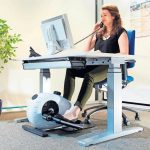
 Lucas J. Carr, PhD, Principle Investigator, Assistant Professor, Department of Health and Human Physiology, University of Iowa
Lucas J. Carr, PhD, Principle Investigator, Assistant Professor, Department of Health and Human Physiology, University of Iowa
Abstract provided by PI: Prolonged sedentary behavior is an independent risk factor for multiple chronic health diseases and a cause of musculoskeletal discomfort. Individuals working in full-time, sedentary occupations spend more than 75% of work time sitting placing them at increased risk for sedentary caused conditions. We will recruit 38 adults working in full-time, sedentary (desk-dependent) jobs at an independent worksite (ACT, Iowa City, IA) to participate in a 12 week, randomized controlled trial in which we will test the effects of an intervention that combines: a) replacing sedentary workstations with a novel seated active workstation (LifeBalance Station); and b) an intervention that optimizes computer workstation ergonomics on occupational sedentary behavior, cardiometabolic disease risk factors, musculoskeletal discomfort, and work productivity. Should the aims of this study be demonstrated, we will have identified an effective method of improving the health and well-being of sedentary workers and will have data to support a larger grant submission.
| Results & Dissemination |
 Keeping employees healthy who work in sedentary jobs is an important public health problem. Recently, Lucas Carr, a professor of Health and Human Physiology, was funded by the Healthier Workforce Center to test an intervention to help office workers be more active. The intervention included replacing office workers’ sedentary workstations with active workstations and ergonomic adjustments to each employee’s workstation. The active workstation included a pedal machine that workers could use while engaging in regular work tasks at their desks. Those workers who received the intervention significantly increased the percent of daily work time spent engaging in physical activity. They used the pedal machines for nearly 50 minutes per day. Those that used the pedal machines also showed changes in multiple health outcomes including resting heart rate, weight, and percent body fat. These findings suggest that providing sedentary employees access to a relatively low cost, portable pedal machine that allows for engaging in light intensity activity while at work is an effective and potentially sustainable approach for improving the health of sedentary working adults.
Keeping employees healthy who work in sedentary jobs is an important public health problem. Recently, Lucas Carr, a professor of Health and Human Physiology, was funded by the Healthier Workforce Center to test an intervention to help office workers be more active. The intervention included replacing office workers’ sedentary workstations with active workstations and ergonomic adjustments to each employee’s workstation. The active workstation included a pedal machine that workers could use while engaging in regular work tasks at their desks. Those workers who received the intervention significantly increased the percent of daily work time spent engaging in physical activity. They used the pedal machines for nearly 50 minutes per day. Those that used the pedal machines also showed changes in multiple health outcomes including resting heart rate, weight, and percent body fat. These findings suggest that providing sedentary employees access to a relatively low cost, portable pedal machine that allows for engaging in light intensity activity while at work is an effective and potentially sustainable approach for improving the health of sedentary working adults.
Carr LJ, Leonhard C, Tucker S, Fethke N, Benzo R, & Gerr F (Jan, 2016). Total Worker Health intervention increases activity of sedentary workers. American Journal of Preventive Medicine.
Efficacy of a Combined Ergonomic Health Promotion Intervention on Employee Health (findings from HWCE project). Dr. Lucas Carr- Featured in over 100 news outlets including The Atlantic, Yahoo News, Christian Science Monitor, Consumer Reports on Health, and Science Daily, 2015.
People Who Stand At Work Burn More Calories. Dr. Lucas Carr- Featured, Iowa Public Radio, Dec. 17, 2015.
